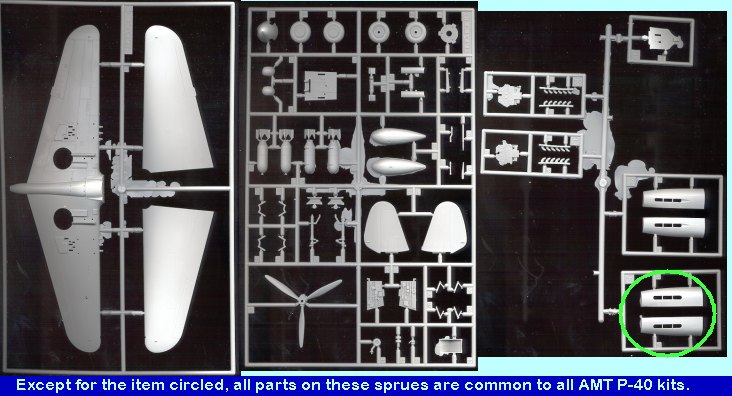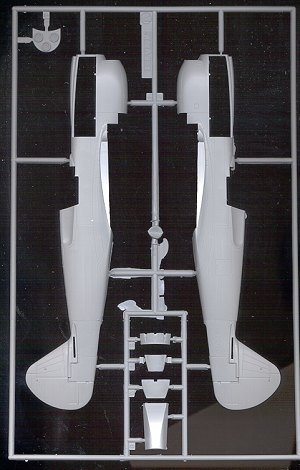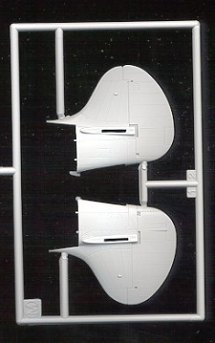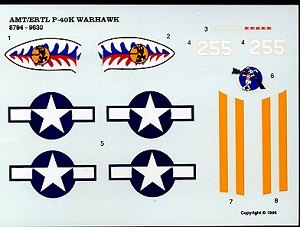
|
KIT: |
AMT 1/48 P-40K Warhawk |
|
KIT # |
8794 |
|
PRICE: |
$13.00 |
|
DECALS: |
One aircraft flown by Maj. Ed Hollmeyer of 16th FS in China in 1943 |
|
REVIEW & |
|
|
NOTES: |
|

|
HISTORY |
Say 'Flying Tigers' and anyone with any knowledge of aviation will think of WW2 and the P-40 in China. They may also think of the John Wayne movie of the same name (which by the way, isn't that bad if you want to see some P-40s, though 'God is My Copilot' is better). Though the Flying Tigers initially flew export P-40Cs, they did receive a number of the improved P-40E version before becoming the 23rd Fighter Group on July 4 1942. It is from the P-40E that the P-40K was developed. A total of 1300 P-40Ks were built and used in all theaters of operation.
Now most aviation enthusiasts have never heard of the P-40K, and that isn't surprising as they were quietly integrated with the other Warhawks in the various units. Nearly identical to the P-40E, the telling visual difference is the addition of a small dorsal fin, giving it a bit of a different look. As with the P-40F before it, there were versions built with extended fuselages, those starting with serial number 42-10265 and being designated P-40K-10's. However only 500 of the K versions produced had this longer fuselage.
|
THE KIT |

 I'm going to
repeat much of what I said about the P-40F previewed earlier. This is a very
nice kit with engraved panel lines as one expects from a relatively new mold.
The interior consists of well detailed side panels, floor, seat with belts
molded in, control stick and instrument panel with rudder pedals. The clear bits
are very clear and flash free. A few of the sprues are valid for all three P-40
kits and those show a lot of flash on them. Unlike the sprue shown above for the
P-40F, there are no 'fishtail' exhausts for this kit which is weird as most K
models had them.
I'm going to
repeat much of what I said about the P-40F previewed earlier. This is a very
nice kit with engraved panel lines as one expects from a relatively new mold.
The interior consists of well detailed side panels, floor, seat with belts
molded in, control stick and instrument panel with rudder pedals. The clear bits
are very clear and flash free. A few of the sprues are valid for all three P-40
kits and those show a lot of flash on them. Unlike the sprue shown above for the
P-40F, there are no 'fishtail' exhausts for this kit which is weird as most K
models had them.
Ordnance consists of two wing mounted 500 lb bombs, again which is unusual as I could find almost no photographs of P-40s with this arrangement, most mounting the bomb centerline. The holes for the mounts are already drilled out which is inconvenient for those of us who won't be using the wing racks. Wheels have the circumflex tread pattern instead of the more common diamond pattern, requiring some aftermarket wheels.
 To do a P-40K from this kit, one needs
to cut off the rear of the kit supplied fuselage (the same one used on the P-40N
which is why you get some extra bits), and replace it with the K tail provided.
BTW, you'll notice that on my example the tip of the tail on one half is
slightly short shot. Good news is that you can use the redundant tail section to
do a long-tailed P-40F or L. Not sure how easy a job this will be so I'd
recommend reinforcing the join area with some plastic card stock.
To do a P-40K from this kit, one needs
to cut off the rear of the kit supplied fuselage (the same one used on the P-40N
which is why you get some extra bits), and replace it with the K tail provided.
BTW, you'll notice that on my example the tip of the tail on one half is
slightly short shot. Good news is that you can use the redundant tail section to
do a long-tailed P-40F or L. Not sure how easy a job this will be so I'd
recommend reinforcing the join area with some plastic card stock.
The
instruction sheet is very good, though it gives no history. Colors are generic
except for camo scheme ones which do have FS numbers. The steps are all
pictorial with no part names, but each part color is called out, another helpful
feature.  There is but one aircraft
scheme, that of Maj. Ed Hollmeyer of the 23rd Fighter Group in Kunming China
circa 1943. You can either do his early markings with no tiger mouth or fuselage
stripes or the other with all the goodies. By the way, the decal sheet shown has
been darkened to show the white letters. The yellow really isn't that orange.
Frankly, I doubt if ANYONE will do the non-tiger mouth scheme and wonder why
another scheme wasn't offered. Well, there are always aftermarket companies who
are more than happy to sell you a nice decal sheet!!
There is but one aircraft
scheme, that of Maj. Ed Hollmeyer of the 23rd Fighter Group in Kunming China
circa 1943. You can either do his early markings with no tiger mouth or fuselage
stripes or the other with all the goodies. By the way, the decal sheet shown has
been darkened to show the white letters. The yellow really isn't that orange.
Frankly, I doubt if ANYONE will do the non-tiger mouth scheme and wonder why
another scheme wasn't offered. Well, there are always aftermarket companies who
are more than happy to sell you a nice decal sheet!!
All in all, it looks like a very nice kit and one that I am surprised has not sold as well as hoped. It is a shame as AMT was releasing some kits of very interesting subjects before it decided to give up on aircraft and concentrate on cars.
|
REFERENCES |
P-40 Hawks at War by Joe Christy and Jeff Ethell, Scribner's and Sons, 1980, $15.95
Review copy courtesy of me and my wallet!
If you would like your product reviewed fairly and quickly by a site that has over 800 visits a day, please contact me or see other details in the Note to Contributors.